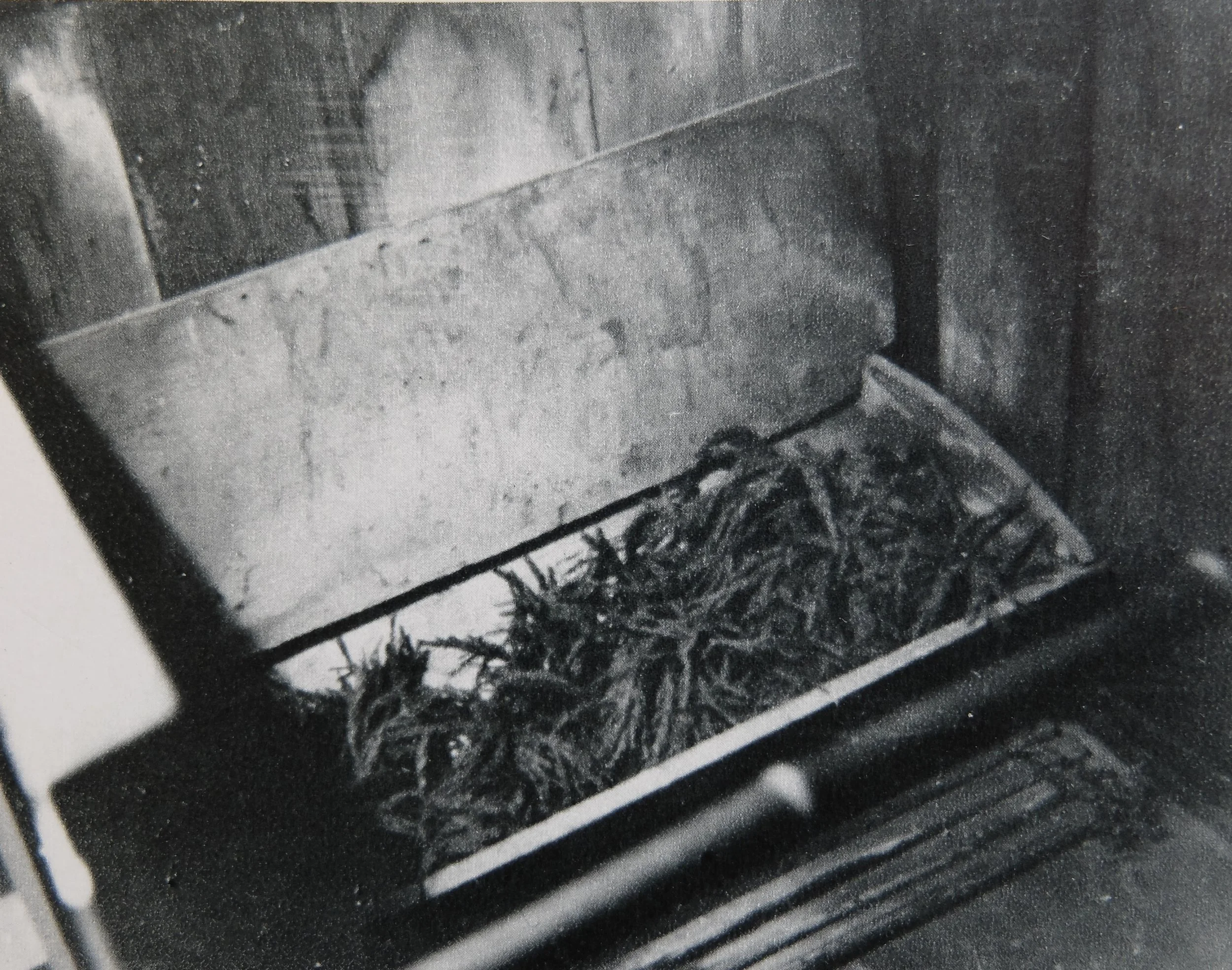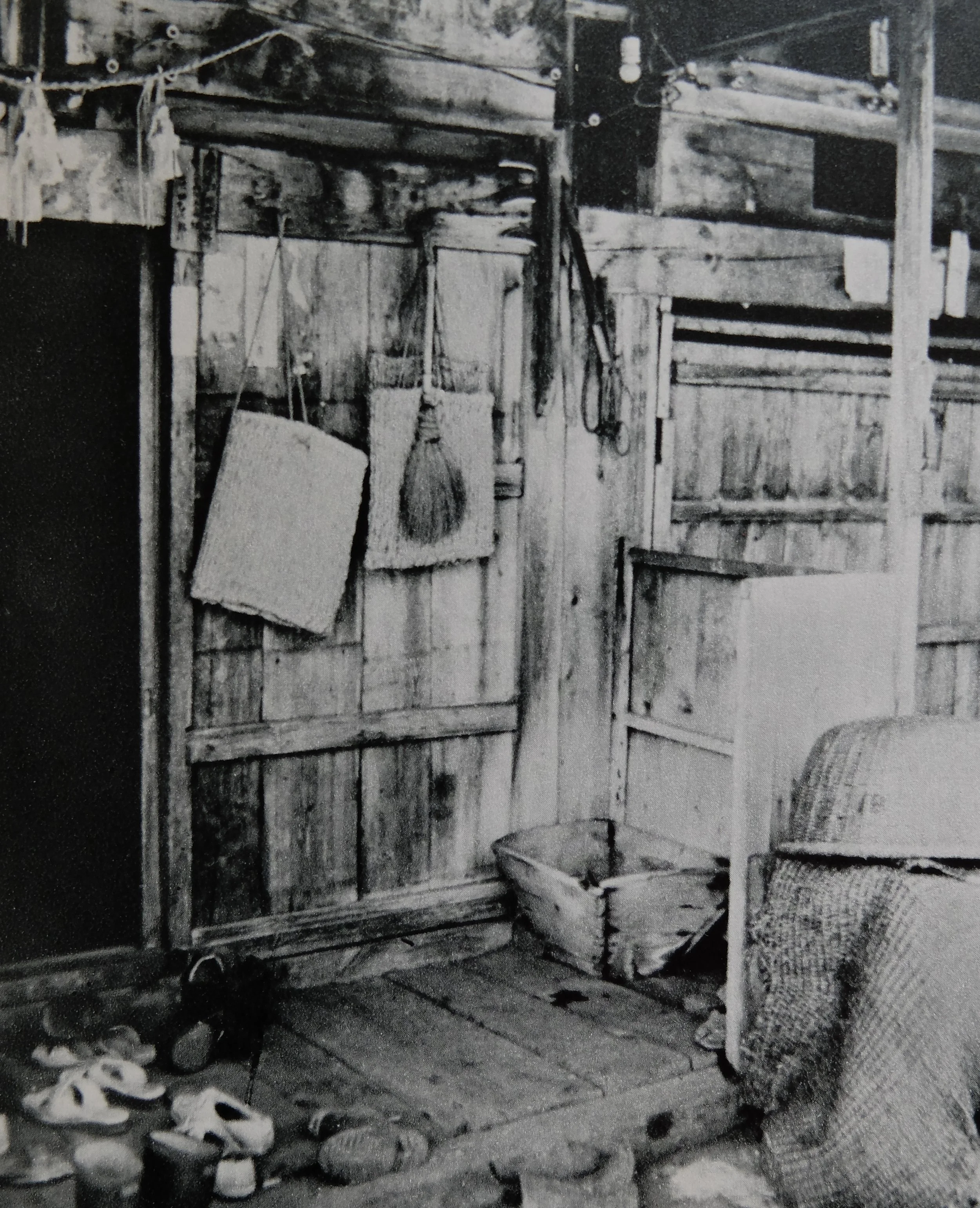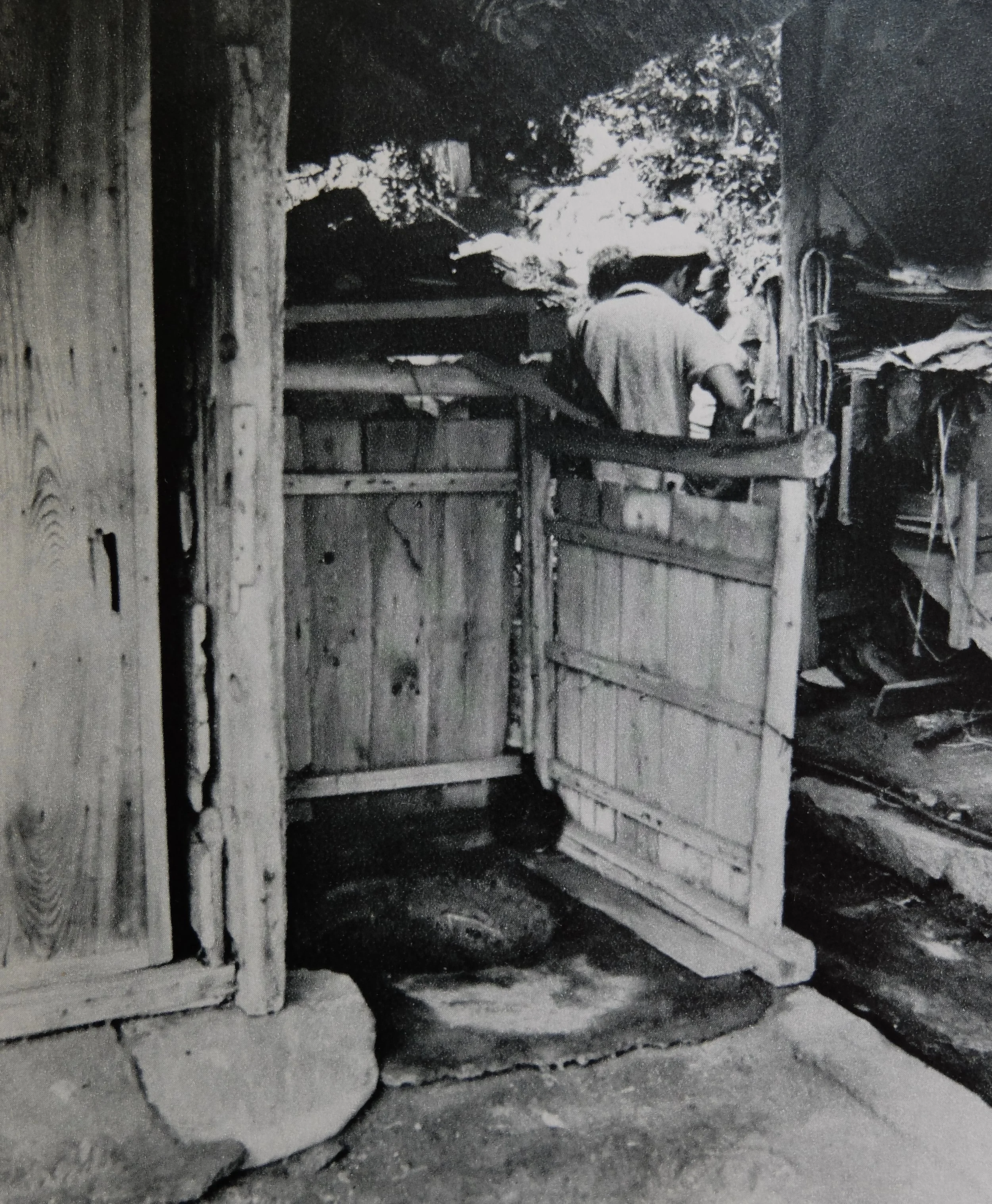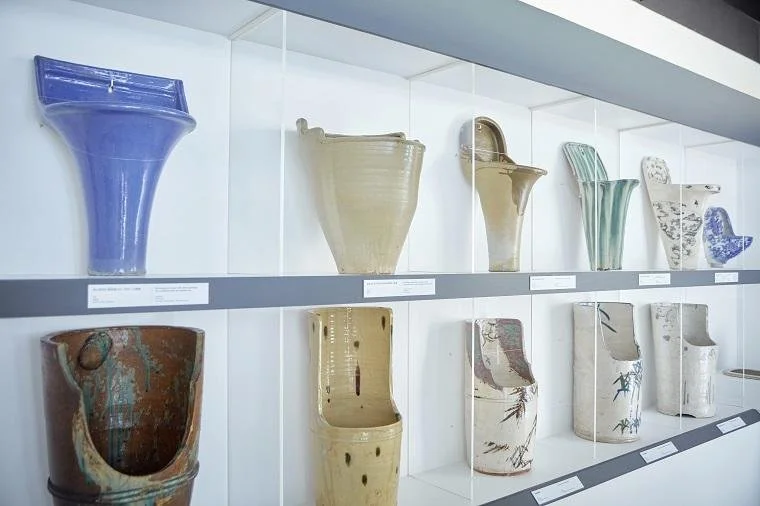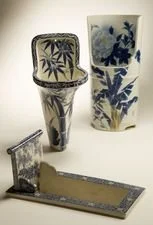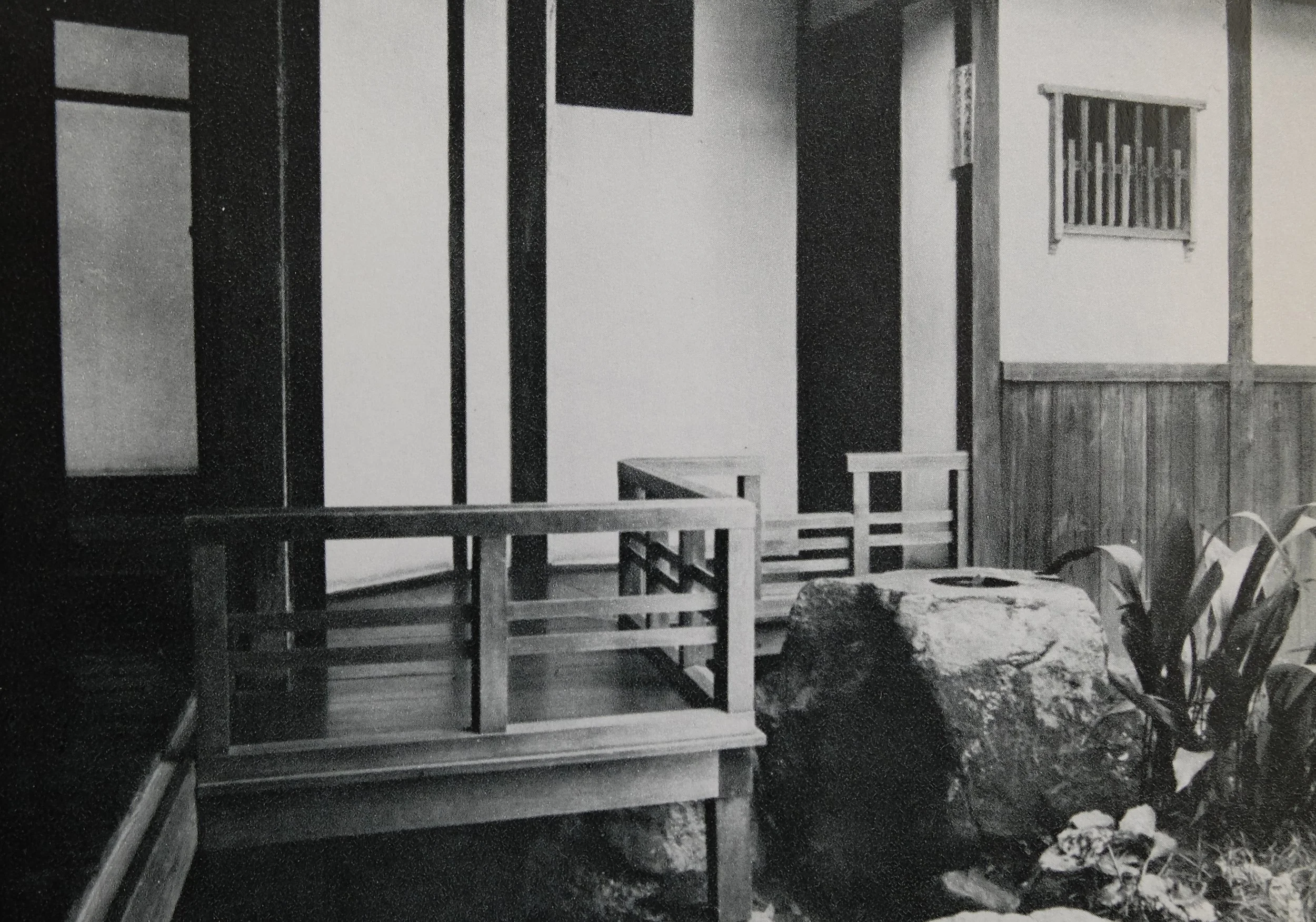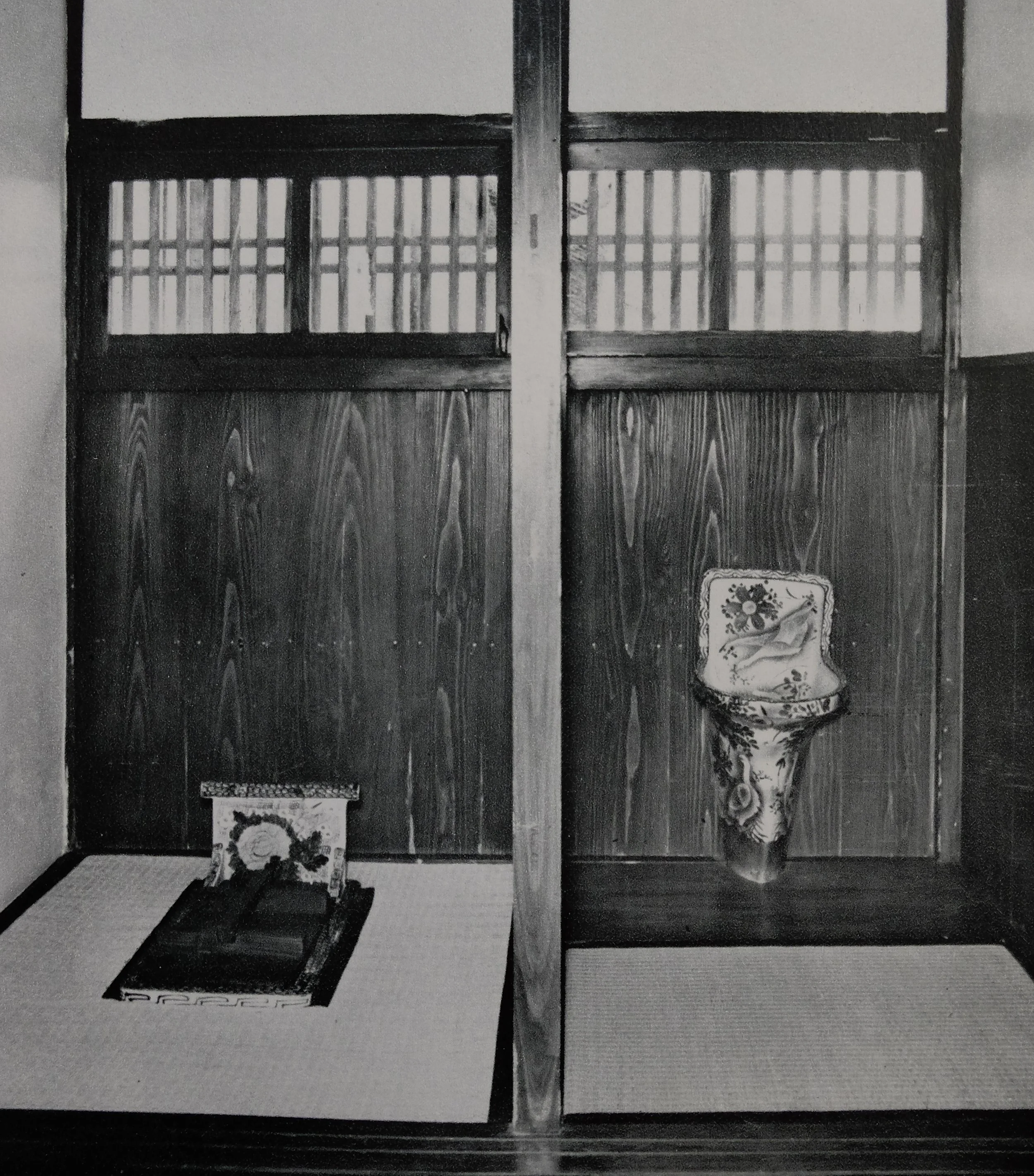Both toilet pan fixtures (ben-ki 便器) and urinal fixtures (shо̄ben-ki 小便器) in minka were made from either timber or porcelain. Porcelain fixtures only became widespread in the Meiji period, fired in the kilns of Seto (瀬戸), Tokoname (常滑), and the Takamatsu (高松) area. They were painted with peony (botan 牡丹) or other floral designs; the Sanuki-benki (讃岐便器) of Takamatsu were particularly famous.
Timber urinals were generally box-shaped (hako-gata 箱型) or ‘funnel’ (jо̄go 上戸 or 漏戸) shaped. To lessen sound and smell and prevent splashback, fresh Japanese cypress (sugi 杉, Cryptomeria japonica) boughs were sometimes laid in them; in some areas urinals themselves were called sugi-ya (杉屋 ‘sugi hut’) and sugi no ha (杉の葉 ‘sugi leaves’).
Fresh Japanese cypress (sugi 杉, Cryptomeria japonica) boughs laid in a timber box-shaped (hako-gata 箱型) urinal; such urinals were called sugi-ya (杉屋 ‘sugi hut’) and sugi no ha (杉の葉 ‘sugi leaves’). Gifu Prefecture.
A doorside (toguchi-waki 戸口脇) timber ‘funnel’ (jо̄go 上戸) urinal. Nagano Prefecture.
An ‘earth pot style’ (do-tsubo-shiki 土壷式) urinal, secured in place with red clay (aka-do 赤土) and lime (sekkai 石灰). Hyо̄go Prefecture.
Porcelain urinals developed out of their timber predecessors, with styles such as the ‘morning glory’ (asagao 朝顔, Ipomoea nil), and mukо̄-daka (向高, lit. ‘opposite high’), modelled on a timber stave bucket with lower staves on one side and higher staves on the other.
A collection of antique porcelain urinals in a museum. Most on the top row are ‘morning glory’ (asagao 朝顔) style fixtures; those on the bottom row are mukо̄-daka (向高, lit. ‘opposite high’), modelled on timber stave buckets.
At their simplest, toilet pans were just holes in the floor, with a vertical timber ‘splashback’ called a mae-tate (前立て ‘front standing’) in front of the hole, and a timber lid (futa 蓋). The mae-tate was also called kin-kakushi (きんかくし, lit. ‘ball (testicle) hider’). It not only clearly demarcates the toilet space into front and back, but also provides something for users, especially infants, to hold onto, and contains ‘overshoot’. The name kin-kakushi suggests that it was intended for men, but among toilet-makers there are those who say that it is women who are the ‘splash-prone’ (hisan no о̄i 飛散の多い) sex, and that the mae-tate is for them. Porcelain toilet pans were known as shimo-hako (下箱 ‘lower box’), and like porcelain urinals, were often ‘ceramicised’ versions of earlier timber forms.
Examples of the famous Seto ware. From right: a ‘morning glory’ (asagao 朝顔) style urinal, a mukо̄-daka (向高) style urinal, and shimo-hako (下箱) toilet pan. The pan and its ‘splashback’ (mae-tate 前立て) with cylindrical top-rail are clearly modelled on a timber predecessor.
In the upper formal rooms (kami-zashiki 上座敷) of the dwellings of upper-class farmers and officials, an ‘upper toilet’ (kami-benjo or ue/uwa-benjo 上便所), accessed via an associated ‘verandah’ (en), was provided. The most sumptuous of these were called dai-benjo (大便所, ‘big/great toilet’), tatami-laid rooms of around two jо̄ (帖), roughly 3.3m2, in area, some with lacquered (urushi-nuri 漆塗り) timber pans. Even in kami-benjo not appointed to this degree, the floor might be a single board of camphor (kusunoki 楠, Camphora officinarum) wood, and the pan fitted with a lid to prevent odour from rising and competing with the fragrance of the camphor. The urinal could be similarly luxuriously appointed, with for example a smoked bamboo (susu-take 煤竹 lit. ‘soot bamboo’) grating around the base of the fixture. In these kami-benjo and in the toilets of townhouses (machiya 町家), a ‘fertiliser pot’ (koe-tsubo 肥壷) called a gesu-game (下須甕), like an enlarged earthenware mortar (suri-bachi 摺鉢), was set into the ground under the pan. Urban ‘night soil’ was collected and sold as fertiliser to farmers, with the waste of higher-class households, with their more nutritious diets, said to command higher prices.
An ‘upper toilet’ (kami-benjo 上便所) built at the end of a ‘crossover corridor’ (watari-rо̄ka 渡り廊下) that leads from the ‘verandah’ (en 縁) of the zashiki. Nara Prefecture.
A tatami-floored kami-benjo (上便所). The porcelain fixtures are sumptuously decorated with peony patterns. The toilet pan has a wooden lid. Sakurai family (Sakurai-ke 桜井家) residence, Ishikawa Prefecture.
A pair of porcelain toilet slippers.
In remote areas, one could still see in the 20th century large wooden boxes filled with leaves placed in front of toilet pans. While urban areas were a different story, in the countryside it was the norm right up to the Taisho era (Taishо̄ jidai 大正時代, 1912 - 1926) to use leaves and rice straw, either chopped or scrunched up, to wipe. This material was called otoshi-wara (落し藁, ‘dropping straw’). Alternatively, wood scraps (moku-hen 木片) somewhat like disposable chopsticks (wari-bashi 割り箸) were used. There was an old adage that if one saw chopsticks washed up in the shade of a rock in a river valley, one knew that there were people living upstream, but given that chopsticks were not disposable nor thrown away in great numbers in those days, it is likely that the ‘chopsticks’ referred to here were not chopsticks at all, but kuso-bera (糞ベラ or 糞箆, lit. ‘shit spatula’) called chūgi (籌木 or ちゅう木, lit. ‘skewer wood’) or sute-gi (捨て木, lit. ‘throw away wood’), washed down the river.
A collection of old chūgi, with two rolls of toilet paper for scale.
